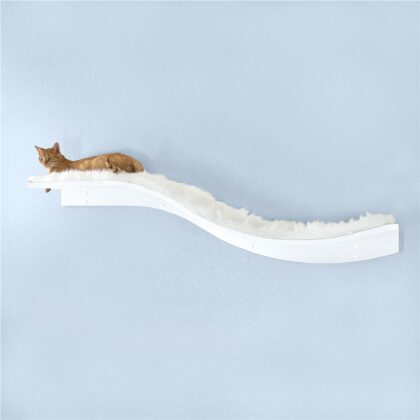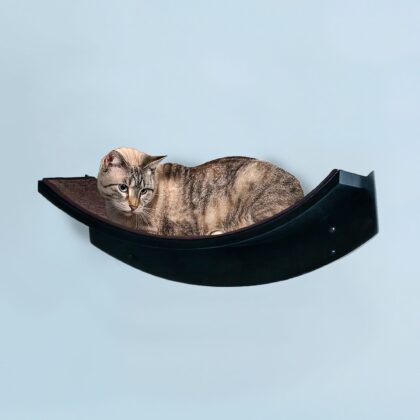
Is My Cat Grooming Too Much?
Cats are known for their meticulous grooming habits. This behavior is not only a cleanliness routine but also a way for cats to regulate their body temperature, calm themselves, and maintain their fur’s insulating qualities. However, like many behaviors, it’s possible for grooming to cross the line from normal maintenance to excessive or compulsive behavior. If you’re noticing your cat spending more time than usual on grooming, it might be time to explore why and how you can help them. In this blog, The Refined Feline explores why and how your cat may be excessively grooming and what to do about it.
Understanding Normal Grooming
Typically, cats spend about 30% to 50% of their day grooming. This normal grooming is evenly spread out and doesn’t result in hair loss or skin damage. A healthy grooming session involves the cat licking its fur to remove dirt and distribute natural oils, which helps keep their coat shiny and skin healthy.
Related: Understanding Common Cat Behaviors
Signs of Excessive Grooming
Excessive grooming, or psychogenic alopecia, goes beyond normal maintenance. Here are signs that your cat may be over-grooming:
- Bald Patches: One of the most apparent signs of over-grooming is bald patches or noticeable thinning of the fur. These areas may appear suddenly and are often found on the belly, legs, and along the sides of the body.
- Skin Irritation or Lesions: Excessive grooming can lead to skin irritation, redness, or lesions. The constant licking can break the skin, leading to potential infections.
- Increased Frequency: If your cat seems to be grooming so frequently that it interferes with normal activities like eating, playing, or sleeping, it’s likely excessive.
- Grooming Abruptly and Intensely: Cats that groom compulsively may start licking intensely out of nowhere. This can be triggered by a stimulus or occur spontaneously.
Reasons Behind Excessive Grooming
Understanding why your cat is grooming excessively is crucial to addressing the behavior. Here are some common causes:
- Stress and Anxiety: Stress is a primary driver of excessive grooming in cats. Changes in their environment, such as a new pet, a new baby, moving houses, or even rearranging furniture, can lead to anxiety-induced grooming.
- Allergies or Skin Conditions: Allergic reactions to food, pollen, fleas, or even certain grooming products can cause skin irritation, leading cats to groom excessively to soothe the itchiness.
- Pain or Discomfort: Sometimes, cats groom specific body areas excessively in response to pain or discomfort. This could be due to injuries, arthritis, or urinary tract infections.
- Boredom: Lack of mental stimulation and physical exercise can lead cats to groom excessively as a self-soothing act.
Combating Excessive Grooming
Once you’ve identified potential reasons for your cat’s excessive grooming, you can take steps to alleviate the issue:
- Veterinary Check-Up: Consult with your veterinarian to rule out medical reasons for excessive grooming. This can include skin tests for allergies or a thorough physical examination to check for any signs of pain.
- Environmental Enrichment: Enhance your cat’s environment with more interactive toys, climbing structures, and scratching posts. Products from The Refined Feline, such as stylish and functional cat towers, can provide your cat with physical exercise and mental stimulation, reducing boredom and stress.
- Stress Reduction: Identify stressors in your cat’s environment and try to eliminate them. You can also use pheromone diffusers, which can help calm your cat. Establish a routine for feeding, play, and cuddling to give your cat a sense of security.
- Diet and Nutrition: Consult with your veterinarian about a diet that supports skin health, particularly if allergies are suspected. Adding omega-3 fatty acids to their diet can improve skin health and reduce itchiness.
- Behavioral Interventions: In some cases, behavioral therapy may be necessary. A veterinary behaviorist can provide guidance on reducing compulsive grooming through behavior modification techniques.
- Interactive Play: Engage your cat in more play sessions throughout the day to keep them occupied and mentally stimulated. The Refined Feline’s innovative toys and furniture can integrate well into such play sessions, making them more engaging for your cat.
Further Steps in Addressing Excessive Grooming
As you manage the initial phases of excessive grooming, here are additional strategies and insights to maintain progress and prevent future occurrences.
Follow-Up Veterinary Care
After the initial veterinary visit:
- Regular Follow-Ups: Schedule regular follow-ups to monitor your cat’s condition, especially if they were prescribed medication or a special diet.
- Monitor Response to Treatment: Keep a log of your cat’s grooming behavior and any changes in their skin condition. This can help your vet adjust treatment plans effectively.
Enhance Daily Interactions
Expanding on environmental enrichment and interactive play:
- Daily Bonding Sessions: Incorporate daily sessions where you engage in grooming your cat with a soft brush. This not only helps to satisfy their grooming needs but also strengthens your bond and provides comfort.
- Creative Play: Change up the types of play and interaction. Use different toys or introduce puzzle feeders that challenge them mentally and divert attention away from grooming.
Consider Professional Behavioral Help
If environmental changes and medical interventions don’t seem to mitigate the grooming:
- Consult a Feline Behaviorist: Sometimes, the issues are deeply ingrained, particularly with rescue cats who may have had traumatic pasts. A behaviorist can offer tailored strategies that might include desensitization techniques or other advanced behavioral modifications.
Dietary Adjustments
Further advice on nutritional support:
- Hydration: Increase your cat’s water intake. Sometimes, excessive grooming can be linked to dehydration. Adding more wet food to their diet or investing in a cat water fountain can encourage them to drink more water.
- Supplements: Discuss with your vet about incorporating supplements that promote skin health. For instance, supplements containing biotin or essential fatty acids can improve skin condition and reduce the urge to groom excessively.
Social Enrichment
Cats are often perceived as solitary animals, but they do benefit from social interaction:
- Social Play: If you have more than one cat, encourage gentle play sessions that can help them burn off energy and reduce anxiety. Monitor these sessions to ensure they remain friendly.
- New Experiences: Introduce new items or changes in the home gradually. New scents, toys, or even rearranging furniture can provide new stimuli that engage their curiosity in healthier ways.
Re-evaluate Environmental Stressors
Continuously assess the living environment:
- Quiet Spaces: Ensure your cat has access to quiet, private spaces where they can retreat when overwhelmed. High perches or hideaways like those provided by The Refined Feline can offer sanctuary spaces.
- Control Noises: Minimize loud noises or sudden disruptions which can elevate stress levels in sensitive cats.
Maintain a Routine
Cats thrive on predictability:
- Consistent Schedules: Maintain consistent schedules for feeding, play, and rest. This predictability can significantly lower stress levels, reducing the likelihood of compulsive grooming.
- Calm Environment: Keep the household environment as calm and predictable as possible. Avoid frequent guests or loud parties if your cat is particularly sensitive.
Community and Support
Finally, consider reaching out to a community of cat owners:
- Online Forums and Groups: These can be invaluable resources for support and advice. Sharing experiences and strategies with other cat owners can provide new insights and emotional support.
Wrapping Up
Addressing your cat’s excessive grooming is a multifaceted approach that spans medical, behavioral, and environmental strategies. It’s about understanding your cat’s unique needs and responding to them thoughtfully. With patience and persistence, you can help your cat overcome this challenging behavior and lead a happier, more balanced life. Remember, each cat is unique, and what works for one might not work for another. Continually adapt and learn from your cat’s behavior, and you’ll find the right balance to keep them healthy and content.










